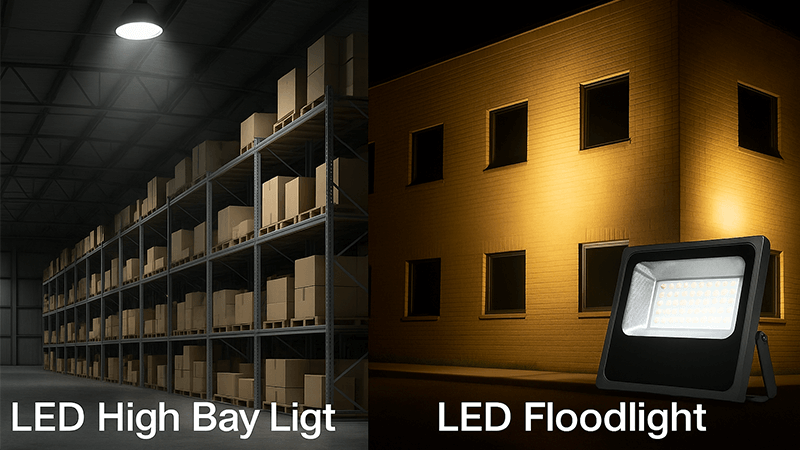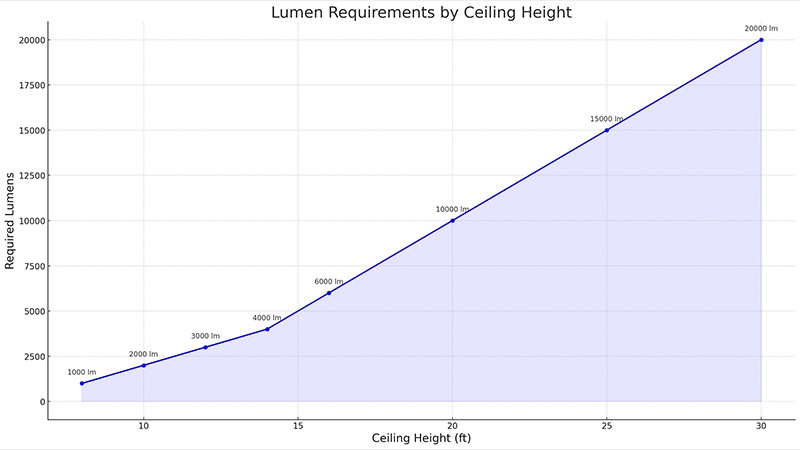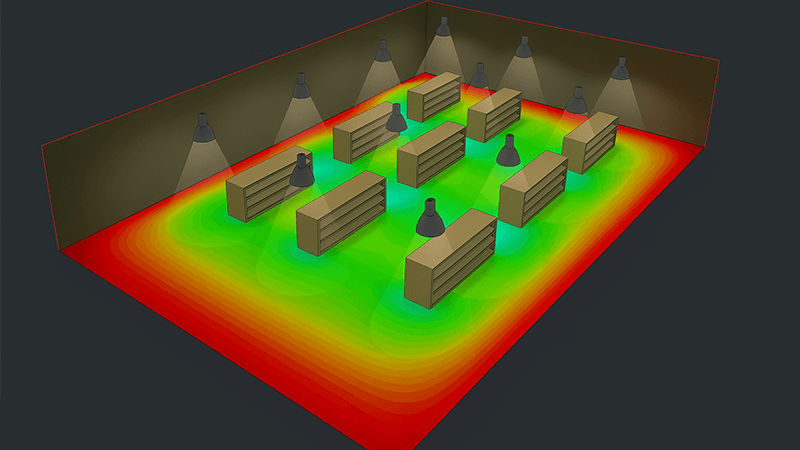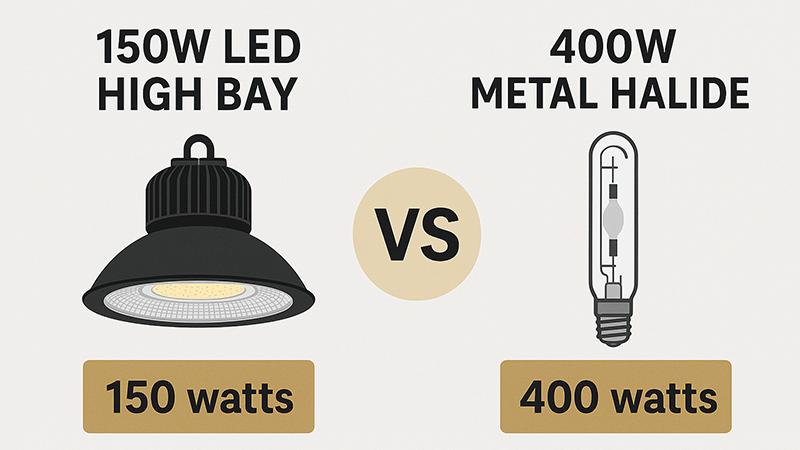Your warehouse has dark corners, causing safety risks and slowing down work. Old lights flicker and burn out, costing you money and maintenance time. You need a reliable lighting solution.
To choose the right LED floodlight, focus on lumen output, CCT (color temperature), CRI (color rendering index), and beam angle. Match these specifications to your warehouse ceiling height and the tasks performed in each area to ensure optimal safety and efficiency.

Choosing the right lighting can feel complex. I have been in the lighting business for many years, starting on the factory floor. I’ve seen firsthand how the right light transforms a workspace. It’s not just about brightness; it’s about clarity, safety, and energy savings. Let’s break down exactly what you need to look for. This guide will walk you through the key factors, so you can make a confident decision for your facility.
What type of lighting is best for a warehouse?
Traditional lighting like metal halide is expensive to run and maintain. The constant replacements and high energy bills drain your budget and disrupt your operations. You need something better.
LED lighting is the best choice for any modern warehouse. Specifically, LED high bay lights for high ceilings and LED floodlights for versatile area and outdoor lighting provide unmatched efficiency, lifespan, and quality of light.

When I visit warehouses, the biggest difference between a modern facility and an old one is the lighting. Old warehouses often use fluorescent or metal halide lamps. They take time to warm up, they hum and flicker, and their light quality is poor. Modern warehouses use LEDs. The difference is instant. The light is clean, bright, and uniform.
Why LEDs are the undisputed champions
LEDs are the industry standard for a reason. They consume far less energy than any other lighting type. This means your electricity bill goes down significantly. They also last much, much longer. An LED fixture can last for 50,000 hours or more. That means you spend less time and money on replacements and more time focusing on your business. I helped a client in Dubai switch their 200 metal halide fixtures to LEDs. They saved over 60% on their energy costs and haven’t had to replace a single bulb in three years.
Choosing the Right LED Fixture: High Bay vs. Floodlight
For inside your warehouse, you generally have two main choices: high bay lights or floodlights.
- LED High Bay Lights: These are designed to be mounted on high ceilings (usually 20 feet or higher). They direct powerful light straight down to the floor, illuminating aisles and workspaces effectively. They typically have a circular, UFO-like shape.
- LED Floodlights: These are more versatile. While often used for outdoor areas like loading docks and parking lots, they can also be used inside. They have an adjustable bracket, which means you can aim the light exactly where you need it. This is useful for illuminating vertical surfaces like racking or for specific task areas.
I recommend using a combination. Use high bay lights for general open areas and aisles. Use floodlights for loading bays, under mezzanines, and any area that needs angled, directional light.
The Technology Inside: COB vs. SMD
When you look at a supplier’s data sheet, pay attention to the LED chip type. You will usually see COB (Chip on Board) or SMD (Surface Mounted Device).
- SMD chips are smaller, individual LEDs mounted on a circuit board. This allows for wider, more diffuse light.
- COB chips group many small LEDs into a single, large module. This creates a very intense, focused beam of light.
For floodlights, both can be excellent. The key is how the manufacturer manages heat. I always insist on LED chips with a high Color Rendering Index (CRI ≥ 80) and high brightness (≥150lm/W). A good design with either COB or SMD packaging will ensure great heat dissipation. This reduces light decay, meaning the light stays brighter for longer.
What strength flood light do I need?
You bought new lights, but they’re too dim, and your workers can’t see properly. Or they’re too bright, causing glare and headaches. Both scenarios reduce productivity and increase risk.
The required strength, measured in lumens, depends on your ceiling height and the work being done. For most warehouses, lights between 10,000 and 50,000 lumens are needed. Higher ceilings and detailed tasks require more lumens.

Years ago, everyone asked me about wattage. Today, the most important question is about lumens. Lumens measure the actual amount of light a fixture produces. Wattage only tells you how much energy it uses. Always focus on lumens first, then look at wattage to understand the light’s efficiency. A high-quality light produces many lumens with very few watts.
Matching Lumens to Ceiling Height
The height of your ceiling is the first thing to consider. The higher the light source, the more powerful it needs to be to provide enough light on the floor. It’s a simple rule of physics. As a purchasing manager, you can use this simple guide to estimate your needs when talking to suppliers.
| Ceiling Height |
Recommended Lumen Output per Fixture |
| 12-15 ft (3.5-4.5m) |
10,000 – 15,000 lumens |
| 15-20 ft (4.5-6m) |
15,000 – 25,000 lumens |
| 20-30 ft (6-9m) |
25,000 – 40,000 lumens |
| 30+ ft (9m+) |
40,000+ lumens |
This table is a starting point. It provides a general range for open spaces. But what about specific work areas?
Factoring in Task-Specific Lighting
Not all areas of a warehouse need the same amount of light. A simple storage aisle needs less light than a packing station where workers read labels and inspect products.
- Storage Aisles: These areas are for moving goods. Visibility for navigation is key, but the tasks are not detailed. A lower lumen level is usually fine.
- Packing & Inspection Stations: These are task-intensive areas. Workers need to see clearly to read small text, check for defects, and work accurately. These areas require a higher concentration of lumens directly over the workspace.
- Loading Docks: This is a high-traffic, high-risk area. You need bright, reliable light for safety as forklifts and people move between inside and outside.
I remember a client whose workers in the packing department were making frequent errors. After visiting the site, I saw their lighting was the same as in the storage aisles. It was simply not bright enough. We installed additional, lower-lumen task lights directly above the packing tables. The error rate dropped almost immediately. It’s a small change that makes a huge difference in productivity.
How do you calculate lighting for a warehouse?
You try to guess how many lights you need. You end up buying too many, wasting money on fixtures and energy. Or you buy too few, leaving dangerous dark spots.
A professional lighting calculation uses a formula or simulation software like DIALux. It considers your warehouse area, required lux levels, and the specific light fixture’s data to determine the exact number and placement of lights needed.

As a purchasing manager, you don’t need to be a lighting designer. However, understanding the basics of a lighting calculation will help you have more productive conversations with suppliers. It allows you to check their proposals and ensure you are getting a plan that truly meets your needs. When a supplier gives me a plan, I immediately look for a few key things.
Step 1: Define the Required Lux Level
Lux is the measurement of how much light (lumens) falls on a specific surface area. Different tasks require different lux levels. Industry standards provide clear recommendations. For you, an expert purchaser like Shaz, knowing these numbers is a powerful tool in negotiations and project planning.
| Warehouse Area |
Recommended Lux (lumens/m²) |
Recommended Foot-candles (lumens/ft²) |
| General Storage |
150 – 200 lux |
15 – 20 fc |
| Packing & Shipping |
300 lux |
30 fc |
| Loading Bays |
200 lux |
20 fc |
| Inspection Areas |
500+ lux |
50+ fc |
Step 2: Use the Lumen Method Formula
For a quick estimate, you can use the lumen method formula. It looks complex, but the idea is simple.
Number of Fixtures = (Target Lux × Area) / (Lumens per Fixture × CU × LLF)
Let’s break that down:
- Target Lux: This is the brightness you need from the table above.
- Area: The square meters or square feet of your space (Length x Width).
- Lumens per Fixture: The total light output of one light, which you get from the supplier’s spec sheet.
- CU (Coefficient of Utilization): A factor that accounts for how much light actually reaches the work surface. It considers room shape, surface reflectiveness, and fixture mounting height. A professional will calculate this, but it’s often between 0.6 and 0.9.
- LLF (Light Loss Factor): This accounts for the fact that a light’s output decreases over time due to dirt accumulation and aging (light decay). It’s usually around 0.8 to 0.9.
Step 3: Insist on a Professional Layout
While the formula is good for an estimate, I always tell my partners to insist on a professional lighting design, typically done with DIALux software. It’s something we at Upward Lighting provide for all our project partners. This software creates a 3D model of your warehouse and simulates the exact lighting performance. It shows you exactly where the bright and dark spots will be before you spend a single dollar. This is the best way to guarantee a perfect result.
What is a good wattage for flood lights?
You are used to buying 400W metal halide lamps. So you look for 400W LED replacements. This is a common mistake that leads to buying inefficient or overpriced lights.
Forget about wattage. A good LED floodlight is defined by its high lumen efficacy (lumens per watt), not its power consumption. Look for fixtures that deliver at least 150 lm/W. This ensures you get maximum brightness for minimum energy cost.

In my early days, we measured everything in watts. But with LED technology, wattage is the wrong metric. Focusing on wattage is like judging a car’s performance by the size of its gas tank. What really matters is its efficiency—how far it can go on a gallon of gas. For lights, the efficiency metric is lumen efficacy, or lumens per watt (lm/W).
Think Efficacy, Not Watts
Lumen efficacy tells you how efficiently a light fixture converts electricity (watts) into light (lumens). The higher the number, the better. A poor-quality LED might only produce 100 lm/W. A high-quality one, like the ones we focus on producing, will deliver 150 lm/W or more.
Let’s look at an example.
- A low-quality 150W LED at 100 lm/W produces 15,000 lumens.
- A high-quality 100W LED at 150 lm/W also produces 15,000 lumens.
Both lights give you the same amount of brightness, but the 100W fixture uses 33% less energy. For a purchasing manager like Shaz, responsible for costs, this is a critical detail. Over thousands of operating hours, the energy savings from choosing a high-efficacy fixture are enormous.
Replacing Old Technology: A Simple Comparison
You are likely replacing old, inefficient lighting. The energy savings are one of the biggest selling points for any LED upgrade project. Here is how a modern, high-efficacy LED floodlight compares to the old technology it replaces.
| Old Technology |
Power Usage |
Modern LED Floodlight (150 lm/W) |
Power Usage |
Energy Savings |
| 400W Metal Halide |
400W |
22,500 Lumen LED Floodlight |
150W |
~62% |
| 1000W Metal Halide |
1000W |
45,000 Lumen LED Floodlight |
300W |
~70% |
| 500W Halogen |
500W |
15,000 Lumen LED Floodlight |
100W |
~80% |
When I present these numbers to clients, they are often surprised. The savings on the electricity bill alone often mean the payback period for the entire lighting project is less than two years. It’s one of the easiest investments a business can make with a guaranteed return. Always ask your supplier for the lumen efficacy (lm/W) of their floodlights. If it’s not high, you are leaving money on the table.
Conclusion
Choosing the right warehouse floodlight is easy when you focus on the right things. Prioritize high lumen output, superior efficacy (lm/W), and a professional lighting plan for guaranteed performance.